
Specifications
1. ADC Hardware Related Specifications
Sound Card based systems:
1) Scan Time: 100
µs~500 s (computer memory dependent).
2) Bandwidth: 10 Hz - 200
kHz (sound card dependent).
3) Maximum Allowable Input Voltage
(if connected directly): about 3 V (sound card dependent).
4)
Selectable sampling frequency (up to 768 kHz), sampling bit resolution
(8, 16 24 or 32 bits) and sampling channels (one or two) (sound card
dependent)
5) Four trigger modes: Auto, Normal, Single and Slow.
6) Support triggering by rising edge, falling edge, or both at a
specified trigger level or for a specified amount of change, in the
selected input channel. Support trigger frequency rejection.
7) Support pre-triggering and post
triggering from 0 to 100% of the specified record length.
8)
Continuously monitor the input signal such that no trigger event is
missed before data collection
9) Support calibration of the input
channels with the input gain setting automatically being taken into
account. Re-calibration is not necessary even if the gain setting
changes.
Non Sound Card based systems:
Please refer to the
respective hardware manual.
2. Can be used as a transient signal
recorder to capture and store raw data continuously into a sequence of
WAV files in the hard disk.
3. Five view types: Real time waveform of
Channel A and Channel B, Real time waveform of Channel A + Channel B,
Real time waveform of Channel A - Channel B, Real time waveform of
Channel A × Channel B, Real time Lissajous Pattern for Channel A and
Channel B.
4. Independent X axis and Y axis zooming and scrolling.
5. WAV files and properly formatted TXT files can be imported for
display and analysis.
6. Collected measurement data can be saved
as WAV files or exported as TXT files.
7. Data curve can be
print-previewed, printed out directly or saved as BMP files.
8. Support adding
notes to the measurement data.
9. Fast display refresh rate: about
50 frames per second (tested with a sound card under Windows XP SP2 on
IBM ThinkPad R51 Laptop PC with Intel Pentium M processor 1.60 GHz, with
scan time=10 ms and FFT size=1024 and both the Oscilloscope and the
Spectrum Analyzer running under "Auto" trigger mode). Thus data are
displayed and analyzed in "true" real time.
10. The colors of
display, font size, screen refresh rate are configurable.
11.
Number of points (samples) to be collected per sweep can be fine tuned at one
point's resolution.
12. Display the Maximum, Minimum, Mean, RMS
values of the data per sweep. Therefore it can be used as a voltmeter.
13. Support one cursor reader and two markers which stick to the
measurement data.
14. Five chart types: Line, Scatter, Column,
Bar, and Step. Line width is adjustable. Support SINC
interpolation between samples.
15. Support combining
data from individual channels of different wave files and extracting
part of data from a wave file.
16. Support normal and inverted
display of a waveform.
17. Up to five reference curves can be set
for each channel. The reference curve can be configured by either
copying the current curve, or loading a properly formatted text file or
a previously saved reference file from the hard disk. Reference curves
can be assigned as High-High, High, Low, Low-Low limits.
18.
Support digital filtering (intra-frame processing) such as low pass,
high pass, band pass, band stop and arbitrary. The filter class can be
FFT, FIR or IIR. Support inter-frame processing including linear and
exponential average. Support demodulation (AM, FM, PM), DC removal and
rectification. Support removal of time delay between two channels. Support time domain parameter measurements
including reverberation and speech intelligibility, waveform discontinuity, step
response, echo, and damping ratio.
19. Support
loading long WAV file frame by frame, either manually or automatically.
20. Each frame of data is time stamped with an accuracy of 1ms.
21. The data in the graph can be copied into the clipboard as text
and later paste into other software such as Microsoft Excel for further
analysis. The image of the graph can be copied into the clipboard as
Bitmap image and later paste into other software such as Microsoft Word.
22. The waveform displayed in the Oscilloscope can be played or
cyclically played via the default computer sound card, if the sampling
rate and bit resolution of the waveform is compatible with the sound
card. Otherwise, it is possible to adjust the replay sampling rate so
that the signal is pitch shifted into the audio frequency range.
23. The screen display can also work in “Roll” mode.
24. Support waveform conversion between acceleration, velocity and
displacement. Support both SI and English unit systems.
25. Support engineering unit conversion.
26.
Support auto setting of sampling parameters such as sampling frequency,
sweep time and full-scale ADC range. Support Auto Ranging and Auto
Scaling.
27. Support digital
persistence (phosphorescent, rainbow) mode and equivalent time sampling
mode.
28. Support mixed signal (analog and digital) display.
29. Supports Multilingual User Interface under Windows 2000, XP,
Vista, 7, 8, 8.1, 10, 11 and above. Currently supported languages are English,
French, German, Italian, Portuguese, Spanish, Russian, Simplified
Chinese, Traditional Chinese, Japanese and Korean.
Examples
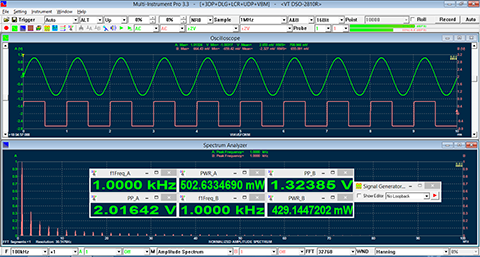
Sine and square waves
|
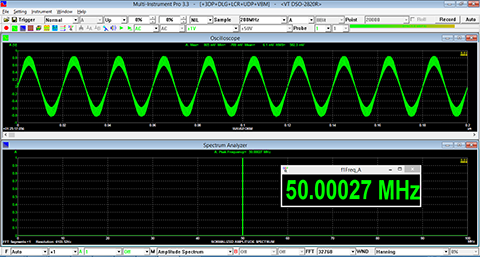
50MHz sinewave sampled at 200MHz with Oscilloscope in
persistence mode
|

Frequency
sweep captured under oscilloscope persistence mode
|
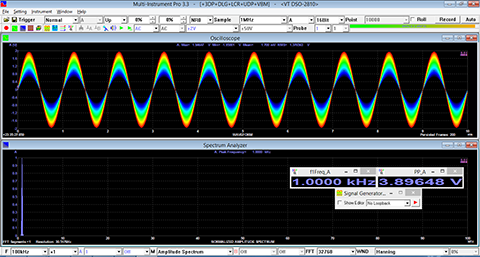
Amplitude sweep (sine) captured under oscilloscope persistence mode
|

Amplitude sweep (square) captured under oscilloscope persistence
mode
|
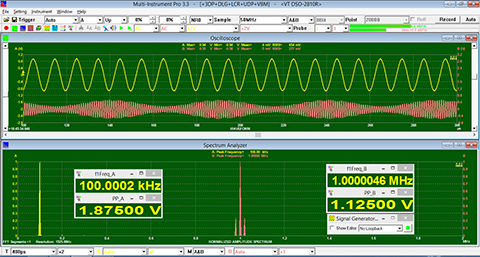
Amplitude Modulation measurement
|

Frequency Modulation measurement
|
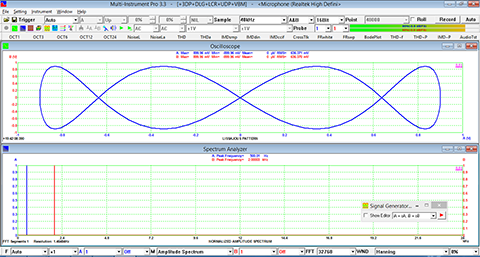
Lissajous Pattern
|
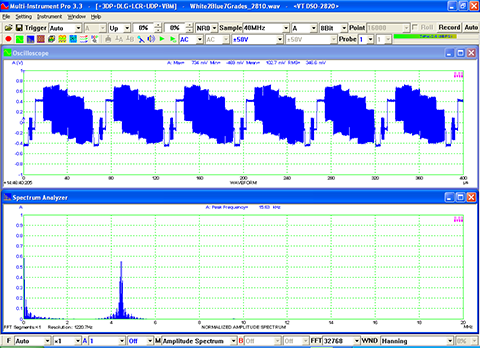
PAL signal measurement
|

SINC Interpolation Mode (80MHz sampled at 200MHz)
|

Rotating Lissajous Pattern under Oscilloscope Persistence Mode
|

Envelope Detection (AM Demodulation)
|

FM Demodulation
|

PM Demodulation
|

Reverberation Time (RT60) Measured by Interrupted Noise Method
|

Reverberation Releated Acoustic Parameters Measured By Impulse
Response Method
|

Glitch (Discontinuity or Dropout) Detected during a Frequency
Sweep
|

Step
Response Parameter Measurement
|

Fluid Level Measurement in Oil & Gas Well through Echo Sounding
|

Ultrasound Burst Extraction Through Digital Filtering (Before:
blue, After: red)
|

Fluid Level Measurement in Oil & Gas Well through Echo Sounding
(Multiple Echoes)
|

Damping Ratio Measurement
|

Measurement of Apparent Power, Real Power, Reactive Power &
Power Factor using A×B
|
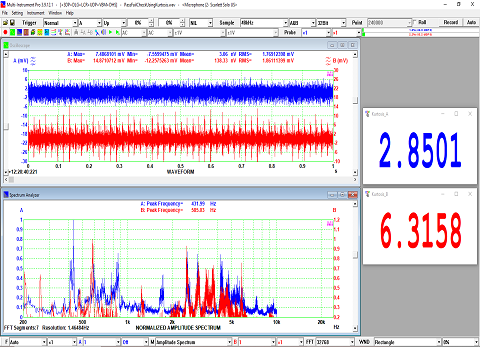
Motor Pass/Fail Check using Kurtosis (Pass: Blue, Fail: Red)
|
|